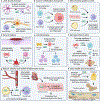The power and potential of mitochondria transfer
- PMID: 37938702
- PMCID: PMC11590279
- DOI: 10.1038/s41586-023-06537-z
The power and potential of mitochondria transfer
Abstract
Mitochondria are believed to have originated through an ancient endosymbiotic process in which proteobacteria were captured and co-opted for energy production and cellular metabolism. Mitochondria segregate during cell division and differentiation, with vertical inheritance of mitochondria and the mitochondrial DNA genome from parent to daughter cells. However, an emerging body of literature indicates that some cell types export their mitochondria for delivery to developmentally unrelated cell types, a process called intercellular mitochondria transfer. In this Review, we describe the mechanisms by which mitochondria are transferred between cells and discuss how intercellular mitochondria transfer regulates the physiology and function of various organ systems in health and disease. In particular, we discuss the role of mitochondria transfer in regulating cellular metabolism, cancer, the immune system, maintenance of tissue homeostasis, mitochondrial quality control, wound healing and adipose tissue function. We also highlight the potential of targeting intercellular mitochondria transfer as a therapeutic strategy to treat human diseases and augment cellular therapies.
© 2023. Springer Nature Limited.
Conflict of interest statement
COMPETING INTERESTS
J.R.B. has pending patent applications related to mitochondria transplantation for the treatment of mitochondrial disorders and lipid metabolism; immunoassays for serum free light chains; and an immunotherapy for atopic dermatitis. He is a member of the Scientific Advisory Board for LUCA Science, Inc., has consulted for DeciBio and Flagship Pioneering within the past 12 months, and receives royalties from Springer Nature Group. N.B. is a consultant for Santa Ana Bio and an advisor for Omniscope.
Figures


References
-
-
Spees JL, Olson SD, Whitney MJ & Prockop DJ Mitochondrial transfer between cells can rescue aerobic respiration. Proceedings of the National Academy of Sciences 103, 1283–1288, doi:10.1073/pnas.0510511103 (2006).
This article was the first to demonstrate that ρ0 cells can obtain mitochondria from neighboring cells to rescue aerobic respiration and support energetically demanding processes such as cell division.
-
Publication types
MeSH terms
Substances
Grants and funding
LinkOut - more resources
Full Text Sources
Other Literature Sources

